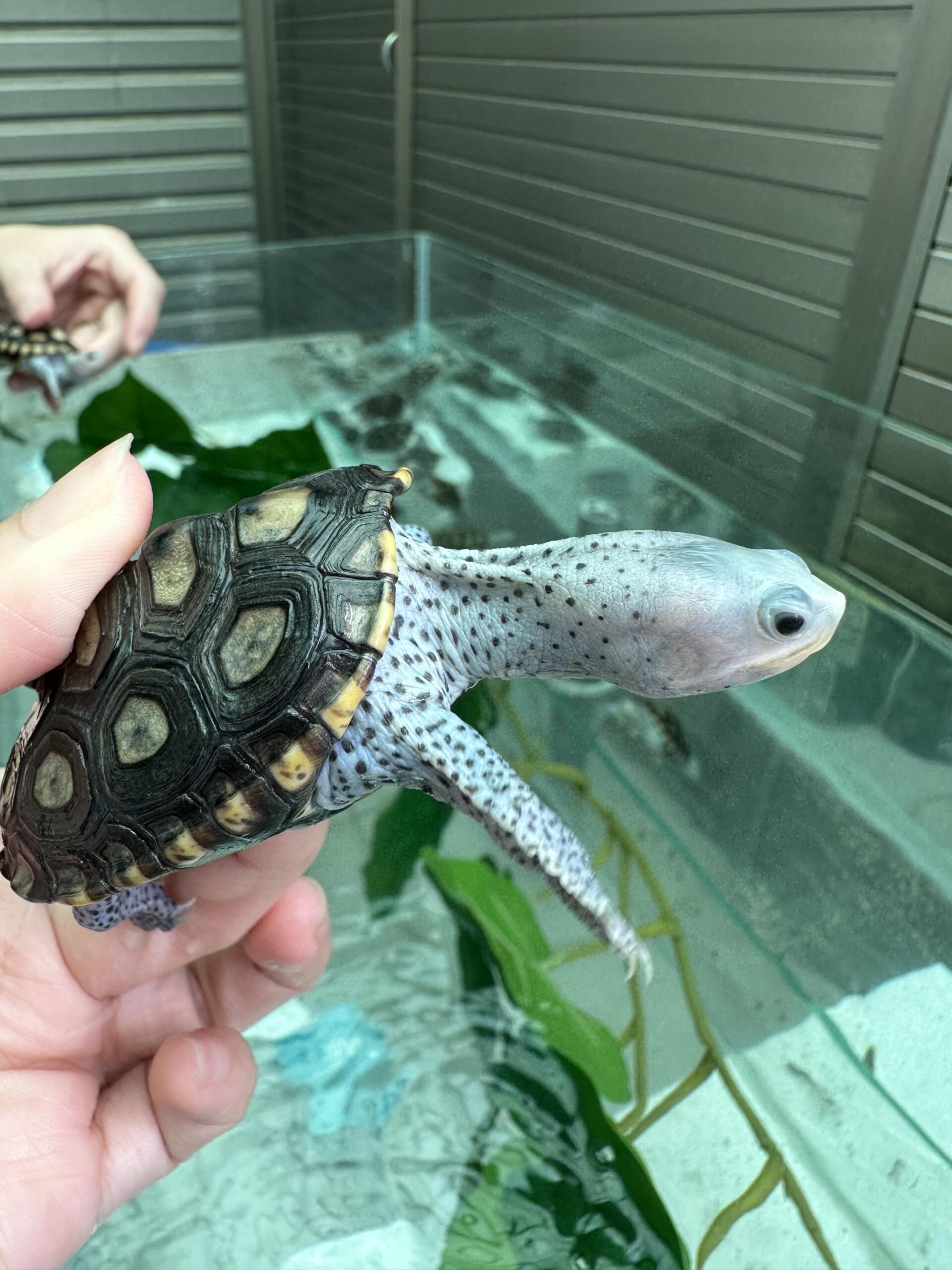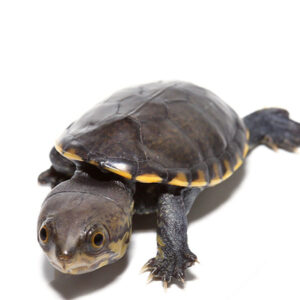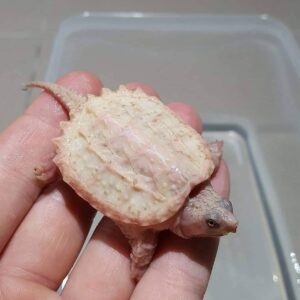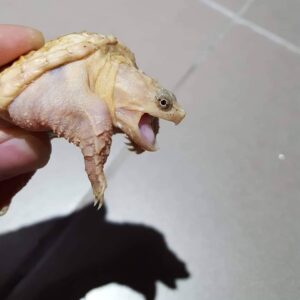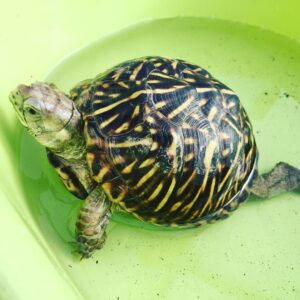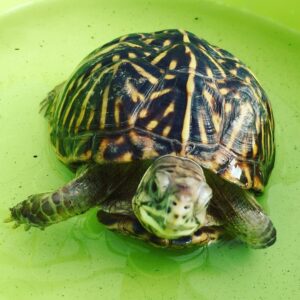Giant Mata Mata Turtle For Sale
$349.99
WE HAVE GIANT MATA MATA TURTLE FOR SALE. HERE ARE SOME HIGHLIGHTS:
- Chelus fimbriata
- Field Collected
- Approximately 12 – 14 Inches In Shell Length
- Adults Can Reach Up To A Whopping 18 Inches And Weigh As Much As 33lbs
- Feeding On Silverside Fish, Crickets And Worms
FUN FACTS!
- Naturally Occurring Out Of South America In The Amazon And Orinoco Basins
- There Necks Are Super Long Allowing It To Snatch Prey From A Far Distance
- One Of Natures Most Interesting Animals With Its Leaf Shaped Head
- High Ridges On Shell And Beautiful Autumn Colors On These Animals
- With Proper Care These Turtles Can Live 40 – 75 Years In Captivity
Description
Giant Mata Mata Turtle
The giant Mata Mata turtle, scientifically known as Chelus fimbriata, is a captivating species native to the slow-moving rivers and swamps of South America, particularly in the Amazon and Orinoco basins. This enigmatic reptile belongs to the family Chelidae, which encompasses various side-necked turtles. Among its kin, the Mata Mata turtle stands out due to its extraordinary appearance and unique adaptations that have intrigued both scientists and enthusiasts alike.
One of the most striking features of the giant Mata Mata turtle is its peculiar physical appearance. Its shell, often covered in algae and resembling a piece of bark, serves as a perfect camouflage in its natural habitat. This cryptic coloration, along with a flattened, triangular head adorned with numerous flaps of skin and a long, tubelike snout, makes the Mata Mata turtle appear almost prehistoric. These physical traits not only aid in its camouflage but also play a crucial role in its hunting strategy, as the turtle remains motionless, blending seamlessly with its surroundings while waiting for unsuspecting prey.
The Mata Mata’s unique physical characteristics extend beyond mere aesthetics; they are vital to its survival. The turtle’s long neck and wide mouth allow it to employ a specialized method of feeding known as suction feeding. By rapidly expanding its throat, the Mata Mata creates a vacuum that sucks in water along with nearby prey, such as fish and invertebrates. This method is highly efficient, making the Mata Mata a formidable predator in its ecosystem.
What further sets the giant Mata Mata turtle apart is its relatively large size, with adults typically reaching shell lengths of up to 45 centimeters (18 inches) and weighing around 15 kilograms (33 pounds). This size, combined with its distinctive appearance and behavior, makes the Mata Mata turtle one of the most fascinating and enigmatic species in the reptile world, captivating the interest of herpetologists and nature enthusiasts alike.
The giant Mata Mata turtle (Chelus fimbriata) is intrinsically linked to its unique and specific habitats, primarily found across the freshwater ecosystems of South America. This enigmatic turtle thrives in slow-moving rivers, streams, and swamps where the water is shallow and heavily vegetated. These environments provide the perfect camouflage for the Mata Mata turtle, allowing it to blend seamlessly with the detritus and plant life on the riverbed.
Geographically, the Mata Mata turtle is predominantly distributed in the Amazon and Orinoco basins. These basins, rich in biodiversity, offer the ideal conditions for the turtle’s survival. The Amazon basin, one of the most extensive river systems in the world, encompasses a vast network of waterways that support an abundance of plant and animal life. Similarly, the Orinoco basin, with its myriad of tributaries and wetlands, provides a suitable habitat for the Mata Mata turtle.
The importance of these habitats cannot be overstated. The complex ecosystem of the Amazon and Orinoco basins plays a crucial role in maintaining the biodiversity of the region. For the Mata Mata turtle, these freshwater environments are essential not just for foraging and nesting but also for their overall well-being. The dense aquatic vegetation and slow-moving waters help the turtle remain inconspicuous to both predators and prey, thus ensuring its survival.
Moreover, the health of these habitats directly impacts the population of the Mata Mata turtle. Environmental threats such as deforestation, pollution, and climate change pose significant risks to the delicate balance of these ecosystems. Protecting the freshwater habitats of the Amazon and Orinoco basins is vital for preserving the enigmatic giant Mata Mata turtle and the myriad of other species that depend on these rich and diverse environments.
Physical Appearance and Adaptations
The giant Mata Mata turtle is renowned for its unique and striking physical appearance, which plays a crucial role in its survival. The turtle’s rough, bark-like shell and leaf-shaped head are among its most distinctive features. The carapace, or upper shell, has a rugged texture and coloration that closely resembles a piece of bark or a collection of fallen leaves. This natural camouflage allows the Mata Mata turtle to blend seamlessly into its surroundings, primarily the slow-moving streams and swamps of the Amazon and Orinoco basins.
The leaf-shaped head of the Mata Mata turtle is another remarkable adaptation. Its head is broad, flat, and triangular, with flaps of skin extending from the sides. These flaps, along with its elongated snout, mimic the appearance of a fallen leaf floating on the water’s surface. This deceptive appearance not only helps the turtle avoid predators but also aids in hunting. The Mata Mata turtle is a sit-and-wait predator, relying on its excellent camouflage to ambush unsuspecting prey. It remains motionless, blending into the background, until a fish or other small aquatic creature comes within striking distance. Then, with a swift extension of its neck and a powerful suction action, it captures its prey with remarkable speed and efficiency.
Additionally, the Mata Mata turtle’s limbs are well-adapted for its environment. Equipped with webbed feet and sharp claws, the turtle can navigate the muddy and vegetated waters of its habitat with ease. The webbing between its toes aids in swimming, while the claws provide traction on the soft, slippery substrate. This combination of physical adaptations ensures that the Mata Mata turtle is well-suited to its aquatic lifestyle, allowing it to thrive in its unique ecological niche.
Diet and Feeding Behavior
The giant Mata Mata turtle, a remarkable species native to the slow-moving rivers and swamps of South America, has a diet that primarily consists of fish. This aquatic reptile possesses a specialized feeding mechanism that sets it apart from other turtles. Its unique suction feeding technique is a fascinating adaptation that allows it to thrive in its murky aquatic habitat.
The Mata Mata turtle’s diet is predominantly carnivorous, with fish forming the bulk of its nutritional intake. It occasionally supplements its diet with invertebrates and small aquatic organisms. The turtle’s feeding behavior is heavily influenced by its environment. The slow-moving waters where it resides are filled with unsuspecting prey, making them an ideal hunting ground for the turtle’s ambush predation strategy.
One of the most intriguing aspects of the Mata Mata turtle’s feeding behavior is its suction feeding mechanism. Unlike many other turtles that bite or tear their prey, the Mata Mata uses a rapid expansion of its throat to create a vacuum. This powerful suction draws water and prey into its mouth in a swift, fluid motion. The turtle’s broad, flattened head and wide mouth are perfectly adapted to this method, allowing it to capture fish with remarkable efficiency.
The evolution of this suction feeding technique is a testament to the Mata Mata turtle’s ability to adapt to its surroundings. Its camouflaged appearance, resembling dead leaves and debris, helps it remain undetected by prey. When a fish swims within range, the turtle’s sudden and precise movements ensure a successful capture. This feeding method not only reflects the turtle’s predatory prowess but also its evolutionary ingenuity.
In summary, the Mata Mata turtle’s diet and feeding behavior are a marvel of natural adaptation. Its preference for fish, combined with its unique suction feeding technique, highlights the intricate relationship between this enigmatic species and its habitat. Understanding these behaviors provides a deeper appreciation for the ecological niche the Mata Mata occupies and its role in the aquatic ecosystems of South America.
Reproduction and Lifecycle
The reproductive habits of the giant Mata Mata turtle are as fascinating as the species itself. Mating behaviors typically occur in shallow, slow-moving waters. During the mating season, which usually spans from October to December, males can be observed engaging in elaborate courtship displays to attract females. These displays often include head movements and the extension of limbs, creating a captivating spectacle in their aquatic habitat.
Nesting sites are carefully chosen by the female Mata Mata turtles to ensure the safety and viability of their eggs. Preferred nesting locations are typically sandy or muddy banks near water bodies, where the temperature and moisture levels are conducive to successful incubation. After selecting an appropriate site, the female digs a nest and lays between 12 to 28 eggs. The eggs are then covered with sand or mud to protect them from predators and environmental elements.
The incubation period for Mata Mata turtle eggs ranges from 200 to 220 days, depending on environmental conditions such as temperature and humidity. Once the eggs hatch, the newborns, known as hatchlings, face significant challenges. They must quickly acclimate to their surroundings and develop survival skills to evade predators. Hatchlings measure approximately 3.5 to 4.5 centimeters in length and possess a striking resemblance to adults, with their distinctive triangular heads and rough carapaces.
As Mata Mata turtles grow from hatchlings to juveniles and then adults, they encounter various obstacles. Predation by birds, fish, and other reptiles poses a constant threat, particularly during their early stages of life. Moreover, habitat destruction and water pollution further complicate their chances of survival. Despite these challenges, those that reach adulthood can live for several decades, contributing to the stability of their populations in the wild.
The journey from hatchling to adulthood is a testament to the resilience of the giant Mata Mata turtle. Understanding their reproductive and lifecycle processes is crucial for conservation efforts aimed at protecting these remarkable reptiles and ensuring their continued presence in their natural habitats.
Conservation Status and Threats
The giant Mata Mata turtle, a unique and enigmatic species native to the Amazon and Orinoco basins, faces several significant threats in its natural habitat. Classified as “Least Concern” by the International Union for Conservation of Nature (IUCN), this designation does not imply immunity to environmental and anthropogenic pressures. Habitat destruction is a primary concern, as deforestation and wetland drainage for agricultural expansion and urban development significantly reduce the available natural environment for these turtles. The alteration of waterways and construction of dams further disrupt the delicate ecosystems they rely on.
Pollution poses another substantial threat. The introduction of pesticides, heavy metals, and other contaminants into the Mata Mata’s habitat can degrade water quality and negatively impact their health. Additionally, plastic waste and other pollutants can cause direct harm or entanglement, leading to injury or death. The illegal wildlife trade exacerbates the situation, with these turtles often captured and sold as exotic pets due to their distinctive appearance. This not only decreases their wild populations but also disrupts the ecological balance of their native regions.
In response to these threats, various conservation efforts are underway to protect the Mata Mata turtle. Protected areas and reserves have been established within their habitat range to safeguard critical ecosystems. Environmental organizations and local governments are also collaborating to enforce stricter regulations against illegal wildlife trade and to promote sustainable land-use practices. Public awareness campaigns and educational programs aim to highlight the importance of preserving this remarkable species and its habitat.
Moreover, research initiatives are essential to understanding the ecology and behavior of the Mata Mata turtle, informing more effective conservation strategies. By addressing these threats through a combination of protective measures, habitat restoration, and community engagement, there is hope for maintaining the population and ensuring the survival of the enigmatic giant Mata Mata turtle.
Role in the Ecosystem
The giant Mata Mata turtle holds a pivotal role within its natural habitat, contributing significantly to the health and balance of aquatic ecosystems. Found primarily in the slow-moving rivers, swamps, and marshes of the Amazon and Orinoco basins, this distinctive reptile is an integral component of the food web.
One of the key contributions of the Giant Mata Mata turtle is its role in controlling fish populations. As a carnivorous species, it primarily feeds on fish, employing its unique camouflaged appearance and stealthy hunting techniques to capture prey. By regulating fish populations, the Giant Mata Mata turtle helps to prevent overpopulation, which can lead to imbalances such as the depletion of algae and other aquatic plants. This balance is crucial, as it maintains the health of the ecosystem by ensuring that no single species dominates the aquatic environment.
In addition to controlling fish populations, the Giant Mata Mata turtle plays a significant part in nutrient cycling. When the turtle consumes fish and other prey, it breaks down and digests the nutrients, which are then excreted back into the water. This process enriches the aquatic environment, providing essential nutrients that support a variety of organisms, from microscopic plankton to larger plant species. This nutrient cycling is vital for the productivity and biodiversity of the ecosystem, promoting a healthy and thriving aquatic community.
Moreover, the presence of the Giant Mata Mata turtle can be an indicator of the overall health of the ecosystem. As a species sensitive to changes in water quality and habitat conditions, their abundance or decline can signal shifts in the environmental health of their habitat. Conservation efforts aimed at protecting the Giant Mata Mata turtle, therefore, have the added benefit of safeguarding the broader ecosystem in which they reside.
Through these ecological roles, the giant Mata Mata turtle demonstrates its importance in maintaining the equilibrium of its habitat. Its contributions to fish population control and nutrient cycling underscore its significance in fostering a balanced and sustainable aquatic environment.
Human Interaction and Cultural Significance
The relationship between humans and the enigmatic giant Mata Mata turtle is as complex as it is fascinating. Indigenous communities in the Amazon basin, where the Giant Mata Mata turtle is native, often regard this peculiar reptile with a sense of reverence and intrigue. The unique appearance and behaviors of the Giant Mata Mata Turtle have earned it a place in local folklore and mythology, where it is sometimes depicted as a guardian of the waters or a symbol of patience and wisdom. These cultural narratives highlight the deep connection between the Giant Mata Mata turtle and the people who share its habitat.
Beyond its cultural and mythological significance, the Giant Mata Mata turtle has also found its way into the pet trade, where its exotic appearance makes it a sought-after species. However, the ethical considerations surrounding its captivity are complex. The Giant Mata Mata turtle specialized habitat requirements and unique feeding behaviors make it challenging to care for in a domestic setting. Captive Mata Matas often suffer from health issues related to inadequate environments, improper diets, and the stress of confinement.
Additionally, the capture and trade of Giant Mata Mata turtle can have significant impacts on wild populations. Overharvesting for the pet trade can lead to population declines, disrupting local ecosystems and potentially endangering the species. Conservationists emphasize the importance of sustainable practices and the need for regulations to ensure that any trade in Mata Mata turtles does not threaten their survival in the wild.
The ethical debate surrounding the captivity of Giant Mata Mata turtle underscores the broader issue of wildlife conservation and the responsibilities humans have toward protecting these unique creatures. While the Giant Mata Mata Turtle striking appearance and enigmatic nature make it a captivating subject for both cultural stories and the pet trade, it is crucial to balance human fascination with a commitment to the well-being and preservation of the species.


